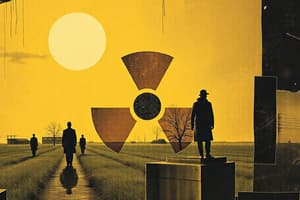Podcast
Questions and Answers
Which type of nuclear radiation is composed of two protons and two neutrons?
Which type of nuclear radiation is composed of two protons and two neutrons?
- Beta particles
- Neutrons
- Gamma rays
- Alpha particles (correct)
What type of radiation requires thick sheets of lead or multiple meters of concrete to stop it?
What type of radiation requires thick sheets of lead or multiple meters of concrete to stop it?
- Alpha particles
- Neutrons
- Beta particles
- Gamma rays (correct)
Which type of radiation can be emitted by a nucleus to increase stability?
Which type of radiation can be emitted by a nucleus to increase stability?
- Neutrons (correct)
- Gamma rays
- Beta particles
- Alpha particles
What is the charge of beta particles?
What is the charge of beta particles?
Which type of radiation is moderately ionizing and can penetrate several meters of air or about five millimeters of aluminum?
Which type of radiation is moderately ionizing and can penetrate several meters of air or about five millimeters of aluminum?
What do isotopes have in common?
What do isotopes have in common?
Flashcards are hidden until you start studying
Study Notes
- Isotopes are different forms of elements with the same number of protons but different number of neutrons, where only one or two isotopes of an element are stable while the rest are unstable and can undergo radioactive decay.
- Radioactive materials consist of unstable isotopes that can decay, emitting particles to become more stable.
- Four types of nuclear radiation are alpha particles, beta particles, gamma rays, and neutrons, each with different properties in terms of ionization and penetration.
- Alpha particles are composed of two protons and two neutrons, have a charge of 2+ and are easily stopped by collisions with other molecules, making them strongly ionizing but with limited penetration.
- Beta particles are electrons with a charge of -1, emitted when a neutron decays into a proton and an electron, moderately ionizing and penetrating materials several meters of air or about five millimeters of aluminum.
- Gamma rays are electromagnetic waves emitted after alpha or beta radiation, weakly ionizing and penetrating far into materials, requiring thick sheets of lead or multiple meters of concrete to stop them.
- Neutrons can be emitted by a nucleus to increase stability if it contains too many neutrons, with minimal information provided about their properties in the text.
Studying That Suits You
Use AI to generate personalized quizzes and flashcards to suit your learning preferences.




